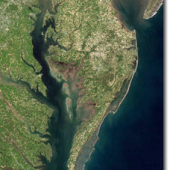Chesapeake Bay Area Facts
The Chesapeake Bay watershed is 64,000 square miles and has 11,600 miles of tidal shoreline, including tidal wetlands and islands. The watershed encompasses parts of six states. Approximately 17 million people live in the watershed; about 10 million people live along its shores or near them.
Chesapeake Bay Overview
Formed about 12,000 years ago as glaciers melted and flooded the Susquehanna River valley, the Chesapeake Bay is North America's largest estuary and the world's third largest.
Chesapeake Bay is approximately 200 miles long and runs north-south from the mouth of the Susquehanna River to the Atlantic Ocean. Chesapeake Bay's headwaters begin at Cooperstown, N.Y., home to the Baseball Hall of Fame.
The Chesapeake Bay watershed (the area of land that drains into the Bay) is 64,000 square miles and has 11,600 miles of tidal shoreline, including tidal wetlands and islands. The watershed encompasses parts of six states: Delaware, Maryland, New York, Pennsylvania, Virginia, and West Virginia, as well as Washington D.C.
The average depth of the Bay, including tributaries, is about 21 feet. The deepest part of the Bay, "the Hole," is 174 feet deep and located off Bloody Point southeast of Annapolis, Md.
The narrowest part of the Bay, near Aberdeen, MD, is about 3.5 miles. The widest point - from Smith Point, VA, to Virginia's Eastern Shore - is 30 miles.
"Chesapeake" derives from the Native American "Tschiswapeki," which loosely translates into "great shellfish bay."
There are more than 100,000 streams, creeks, or rivers in the watershed, including 150 major rivers. One can reach a Bay tributary in less than 15 minutes from nearly everywhere in the watershed.
The Bay's skipjack fleet represents the last commercial fishing fleet to use sail power in North America.
Two of the five major North Atlantic ports--Baltimore and Hampton Roads--are on the Bay.
More than 500 million pounds of seafood is harvested from the Bay every year.
The Bay supports 3,600 species of plant and animal life, including more than 300 fish species and 2,700 plant types.
According to the CBF's 2008 State of the Bay Report the Bay's health rates a 28 out of 100 (a "pristine" Bay circa. 1600). At its worst in the early 1980s, the Bay would have scored a 23. A "saved Bay" would score a 70.
The leading threat to the health of the Chesapeake Bay is excess nitrogen and phosphorus pollution that destroys habitat and causes fish kills. Top sources of these pollutants include agriculture, sewage treatment plants, runoff from urban and suburban areas, and air pollution from automobiles, factories, and power plants. Other threats to the Bay's health include sprawl, toxic pollution, and poor fishery management.
Since colonial times, the Bay has lost half of its forested shorelines, over half of its wetlands, nearly 80 percent of its underwater grasses, and more than 98 percent of its oysters. During the 350 years between 1600 and 1950, approximately 1.7 million acres of the Bay watershed were developed. During the 30 years between 1950 and 1980, the Bay watershed lost an additional 2.7 million acres to development.
The landmark Chesapeake Bay Agreement (a voluntary pledge to Save the Bay signed by the governors of Maryland, Virginia, and Pennsylvania as well as the administrator of the Environmental Protection Agency and the mayor of Washington, D.C.) serves as the blueprint for restoring the Bay's health.

